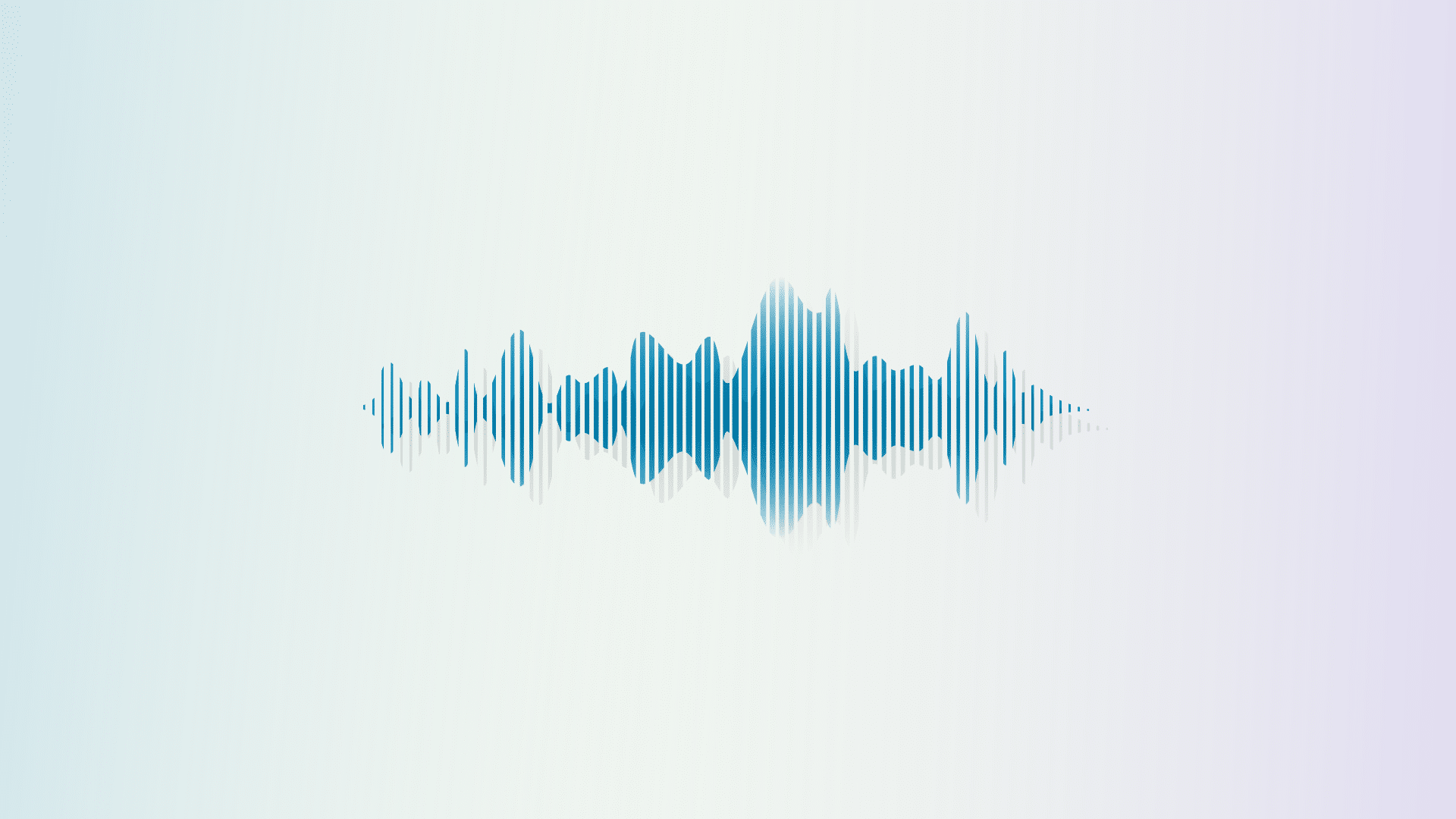Bass sounds are one an important pillars of digital music.
In actual fact, whole genres have been outlined by sure bass sounds.
And the variety of sounds out there’s actually infinite. However there are a number of ones which have stood the check of time.
On this article, I’ve gathered among the hottest bass sounds in fashionable digital music. And collectively, we’re going to learn to make them!
I might be utilizing Very important for all of the sounds – so be certain to obtain it so you’ll be able to observe alongside (it’s free!).
So let’s dive in and drop some bass! 👇
Just a few issues earlier than we begin
Earlier than we dive into some sound designing, I’d like to focus on a number of issues:
- Get as a lot executed within the synth as doable. Minimizing the post-processing will loosen up your CPU load and simplify your workflow. Additionally, be certain to obtain the Glorkglunk and Tam LeTeet wavetable packs from the Very important web site (it’s free!).
- Don’t keep on with only one style when sound designing. For instance, strive a deep home bass in a drum and bass observe. Or a dubstep bass in a techno observe. That’s how you’ll stand out and create your individual sound.
- All the time set Part Randomization to zero. This may guarantee every bass notice is strictly the identical (which is normally the objective with bass sounds):
- When working with bass, take into account mono-compatibility. For those who want a refresher on all issues mono and phasing points, try our newest weblog submit. Briefly, be certain to all the time mono something under 120 Hz.
- Assume exterior the field! In case your bass sound out of the blue works properly as a lead, go for it. Don’t restrict your self.
Now, let’s get into the primary sound!
1. The Plucky Home Bass
Let’s begin with the almighty Pluck Bass sound. Made common by the Korg M1, it’s the sound you hear within the timeless tune Present Me Love:
It is available in at 0:13 – and it doesn’t get a lot funkier than that.
The wonderful thing about this sound is that it acts as a bass and a lead on the similar time.
Let’s dive into Very important and see how one can re-create it.
Let’s open up 2 oscillators, set the primary to a triangle wave and the second to a sq. wave. To do that, merely choose Fundamental shapes, and scroll by means of the waveforms with the slider:
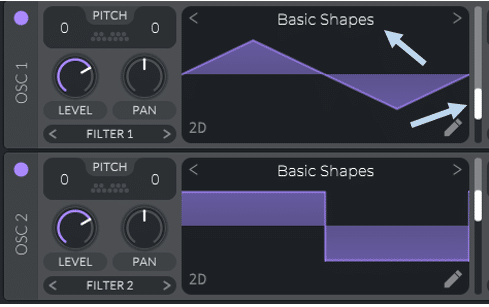
Subsequent, we’re going to pitch down OSC 1 down 2 octaves. You are able to do this simply by holding Shift and scrolling down:

For OSC 2, we’re going to pitch it as much as 7 semitones. This may give us an ideal fifth in relation to OSC 1, creating that good bass-lead relationship.
Subsequent, let’s begin shaping our sound with some ADSR. For those who want a refresher on that and primary sound design, we’ve got you lined.
ENV 1 is assigned by default to the amplitude of all oscillators. Let’s attract one thing one thing “plucky”:
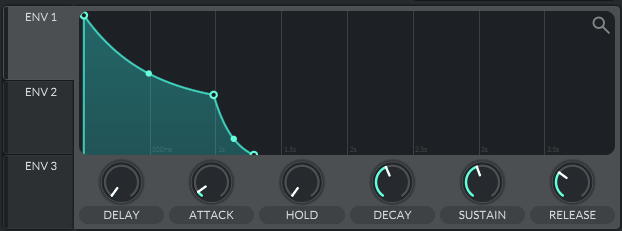
Up to now that is what we’ve bought:
Be sure that “Voices” is ready to 1 and on the underside right-hand aspect of Very important. This may keep away from any notes overlapping one another.
Subsequent, let’s apply some filtering. We’re going to assign ENV 1 to the cutoff of FILTER 1. To do that merely drag ENV 1 over to the cutoff slider of FILTER 1:
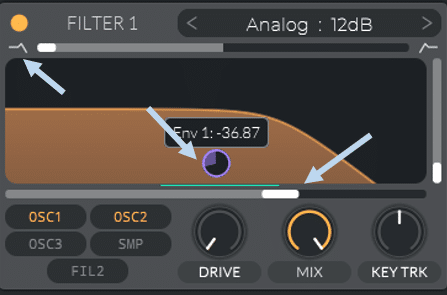
Set your filter to a low-pass, and modify the cutoff level and quantity of filtering to style.
Lastly, let’s add a layer of noise so as to add some character to the sound. Allow the sampler (SMP) and choose a noise. Then, management the amount by means of a brief envelope. You possibly can additionally ship the SMP to FILTER 2 for extra management:

Some delay and reverb, and it’s executed! Let’s have a hear:
Not dangerous for one thing executed 100% inside a free synth proper?
2. The Reese Bass
The Reese bass is a deep, rolling sound principally popularized in drum and bass. Nonetheless, it will also be utilized in different genres akin to synth-wave and fashionable pop.
Imagine it or not, we’re going to obtain this sound with only one oscillator!
Load up Very important and select a sawtooth wave from Fundamental Shapes. The important thing of the Reese bass lies within the Unison Voices:

In Very important, you’ll be able to have as much as 16 voices per oscillator. Let’s take heed to the distinction between 1 voice and 16 voices:
Including detuned voices is what provides the sound its width and thickness. You possibly can management how a lot the voices are detuned by means of the Unison proportion knob.
For this instance, I’m selecting 8 voices, with 22% detuning.
Subsequent, let’s crank up the distortion. Every part might be low-passed in the long run so go loopy:

Lastly, let’s apply a low-pass filter by means of the EQ:

Let’s see what we’ve got:
Not dangerous!
I do know I stated we’d solely use one oscillator. However if you would like extra harmonic content material, experiment with including a second layer:

Lastly, let’s cut up the sub and the remainder of the bass. This manner I can merge the sub to mono to keep away from section cancellation.
To do that, you’ll be able to both duplicate your sound into 2 mixer channels. Or you should use customized plugins akin to FL Studio’s Frequency Splitter:
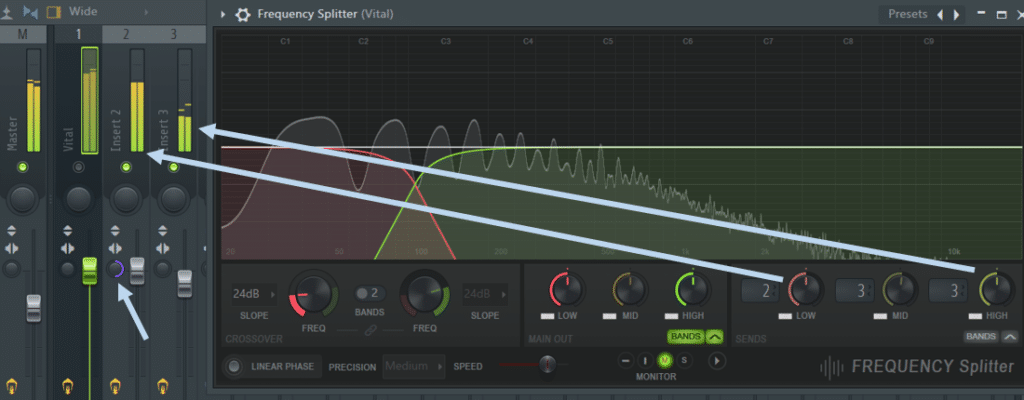
Right here I’ve cut up the sub from the remainder. I then despatched the sub to Insert 2, and the remainder to Insert 3. Lastly, I merged the complete sub to mono.
This received’t change your sound per se, however it is going to make it translate higher over a number of sound methods. So it’s a very good behavior to get into!
3. The FM Dubstep Bass
That is presumably one of the vital recognizable bass sounds of the final decade. Made common by producers akin to Skrillex and Zomboy, the growl-FM-dubstep bass sound outlined a complete period of EDM.
That is fairly a posh one, so hold on!
First, load up an Addictive Squish 2 wavetable into OSC 1 and a Sin into OSC 2. Drop OSC 1 by 3 octaves and OSC 2 by 2 octaves. Set Part Randomization to 0% for each oscillators. Set OSC 2 to frequency modulate OSC 1, and minimize the amount of OSC 2:
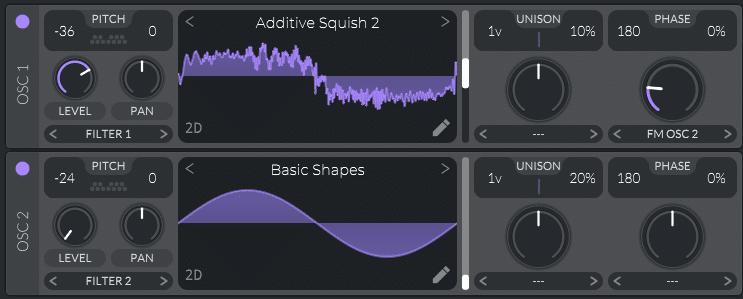
Subsequent, draw within the following form in LFO 1, set to 1/4 notice:

Set a high-pass filter on FILTER 1, and ship LFO 1 to the cutoff and the resonance. Listed below are the settings I used:
- Cutoff at -25 semitones, LFO quantity at 35
- Resonance at 55%, LFO quantity at 0.2
- Drive at 5.6 dB
Ship LFO 1 to additionally automate the amount of OSC 1. At this stage you need to have this sound:
Subsequent, allow OSC 3 and set it to a sq. wave. Drop it by 3 octaves, ship LFO 1 to the extent, and route it to FILTER 2 with the next settings:
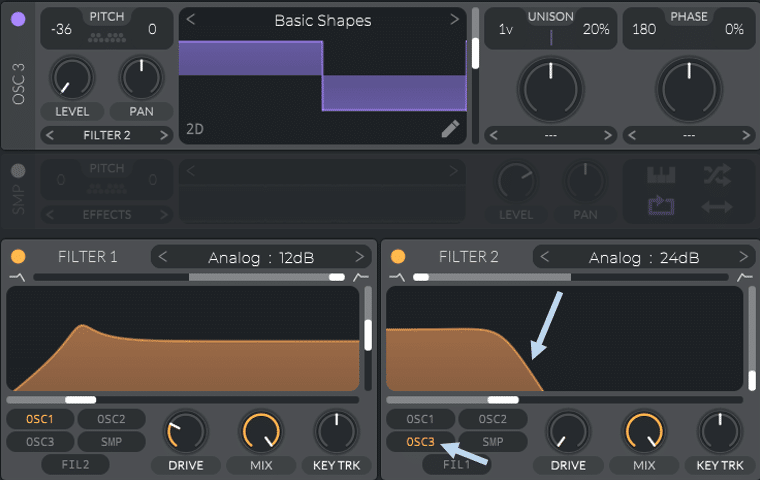
Don’t automate the filter right here as a result of we would like a clear sub. Lastly, ship LFO 1 to modulate the quantity of frequency modulation:

Nonetheless with me? Superior!
Subsequent, let’s transfer on to the FX part. This part is admittedly as much as style, however the objective is to make the sound as aggressive as doable. Refrain, Distortion, and Compression are good locations to start out.
Here’s a snapshot of the FX chain I used:

And that is the sound:
Then set LFO 2 to 2/1 notes, and attract a step sample (choose the comb, and allow “Step”). That is the sample I drew:
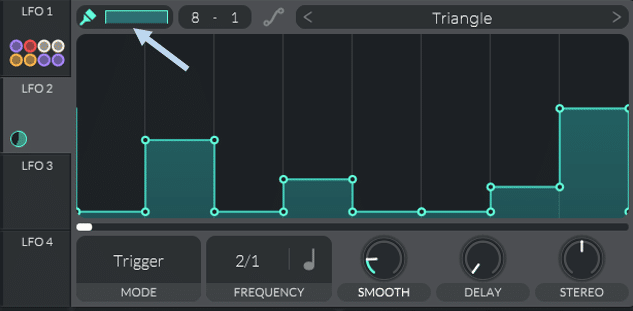
And that is the way it sounds in context with a primary drum sample:
And there you have got it! I’ll cease right here for now as a result of this isn’t a dubstep tutorial (we really simply did one). Let’s transfer on to the subsequent bass sound!
4. The 808 Lure Bass
808s are one of the vital common bass sounds at present. Most hip hop and entice songs at present could have that trademark sound:
An 808 is characterised by its thumpy assault and gradual, pitched-down decay. Let’s see how one can make one!
First, set your “Voices” to 1 and choose a sine wave for OSC 1. Drop it down 2 octaves by holding SHIFT and dragging down. Then set your section to zero:
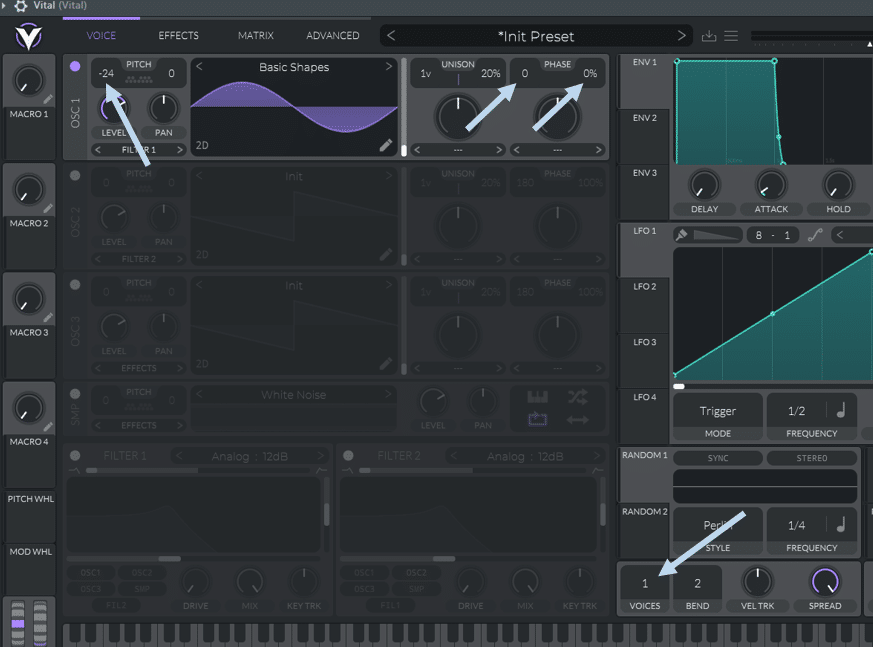
Subsequent, let’s form our 808. Let’s begin with ENV 1 which controls the extent of all oscillators. I’m going to attract within the following form:
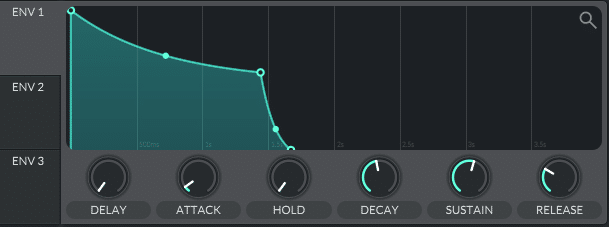
This may give me a pleasant sustained bass. Subsequent, draw the next form in ENV 2:
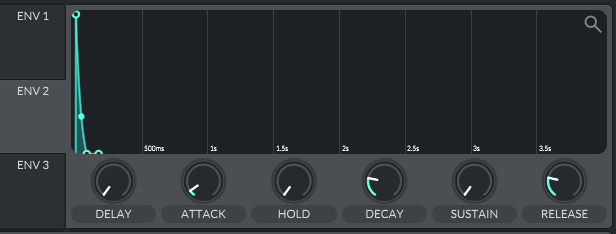
We’re going to use this envelope to automate the pitch of our oscillator. This may give it a pleasant punchy assault.
Within the Matrix tab, left-click underneath Supply and choose ENV 2. Below Vacation spot, choose International, after which Voice Transpose:

We will now management the quantity of “thumpiness” (sorry I actually don’t have a greater phrase for it). I’ll set the quantity to round 19.00, and that is what it feels like:
Good! Now you can return to ENV 1 and form the sound to your liking. You possibly can select a brief maintain if you would like one thing nearer to a kick. Or you’ll be able to preserve loads of maintain for a extra modern-sounding 808.
Moreover, a typical function of 808s is the flexibility to glide between notes. To do that, allow “Legato”, and select the quantity of glide you need:
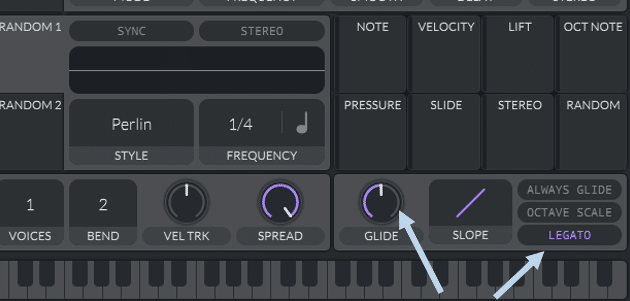
By overlapping notes, you’ll be able to select when the glide happens.
Final step: some distortion! You are able to do this inside Very important or with any inventory or third-party plugin.
This part is admittedly as much as style and depends upon the fashion you’re going for.
I’ve chosen the Mushy Clip distortion in Very important and set the Drive to about 17dB. Here’s what it feels like in context:
And that’s it! You possibly can additionally use parallel processing to dial within the exact quantity of distortion you need.
5. The Techno Rumble Bass
The techno rumble bass is likely one of the most well-known techno bass sounds. Widespread with producers akin to Charlotte de Witte and Amelie Lens, it’s an virtually atonal sound. However it makes for among the hardest drops.
For reference, examine the drop at 3:34 right here:
Doesn’t get a lot heavier than that, does it? Let’s see how one can make a rumble bass!
This part might be a bit completely different in that it isn’t strictly about sound design.
Primarily, a rumble bass is a kick that has been reverbed out like loopy. You low-pass it and sidechain to your most important kick, and also you’ve bought your self a rumble!
Let’s give it a strive. Right here is my primary kick sample:
I’ll duplicate this sample and ship it to 2 separate mixer tracks. One might be my dry kick, one might be my rumble. Proper now each channels will sound an identical.
Let’s begin processing our parallel kick to get a rumble. I’m utilizing Fabfilter Professional-R with the next settings:
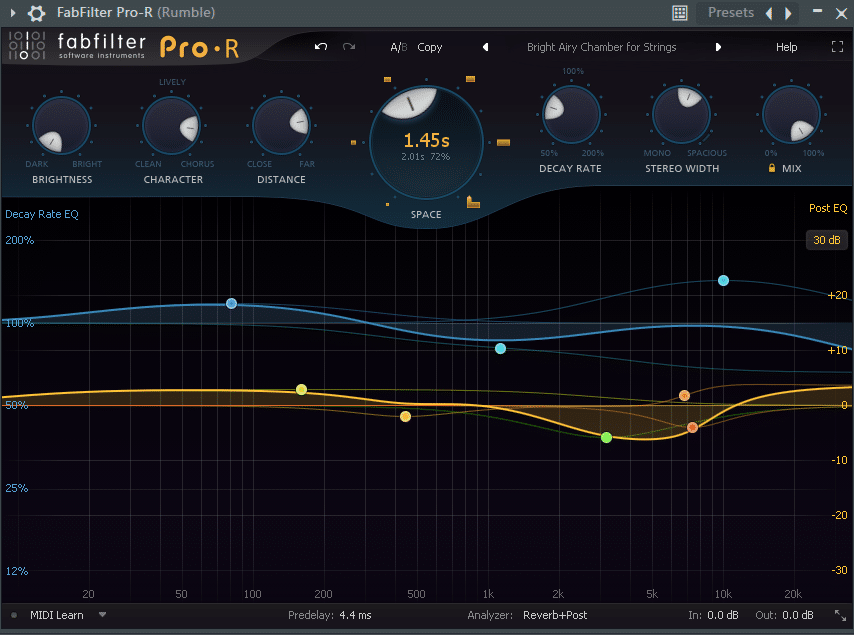
And that is the sound it provides me. Discover that my Combine setting is turned as much as 100%:
Now let’s merge it to mono and apply a low-pass filter. Lastly, sidechain it to your most important kick to get a pumping impact. You are able to do this by drawing in some quantity automation or utilizing a plugin akin to LFO Tool.
On this case, I made a decision to do it manually:

And that is what it feels like:
Fairly simple proper?
You possibly can additionally add compression, saturation, and different ranges of reverb to thicken the rumble.
6. The Acid Bass
Subsequent, let’s dive into the world of acid basslines. This can be a sound that I completely love as a result of you should use into in so many various genres.
For this instance, I’m going to make use of the rumble bass that we simply designed as a basis.
Open up Very important, and choose a sawtooth wave:

I’ve set my Part to zero, however you may modify it barely to introduce some variation.
Observe: there are a ton of free wavetables that you would be able to obtain from the Web. It’s value spending a little bit of time researching to seek out those that suit your style!
Subsequent, let’s sidechain our sign to make it pump together with the kick. For those who want a refresher on all issues sidechaining, be certain to take a look at our newest information!
On this instance, I’ve used a ghost kick to set off the sidechaining:

That is the bassline I’ve written with simply our sawtooth wave:
Subsequent, let’s make the magic occur with some filtering!
In ENV 2, attract a low-sustain curve like such:
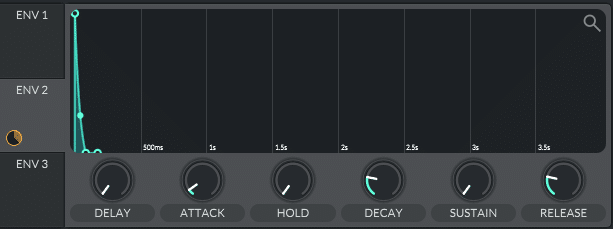
Subsequent, allow Filter 1, and assign ENV 2 to the cutoff of the filter. Select the 24dB low-pass filter.
You need to guarantee that the filter is opening upward (i.e. towards the upper frequencies). Add some resonance and a few drive:

That is what it feels like:
Not dangerous for a easy sawtooth and a few filtering!
One factor that’s fairly widespread is to automate the cutoff over time. The concept is that your acid bassline slowly opens up because the observe progresses.
That is what it will sound like:
Lastly, let’s add some Distortion, Reverb, and Delay. I’m doing every part inside Very important with the next settings:
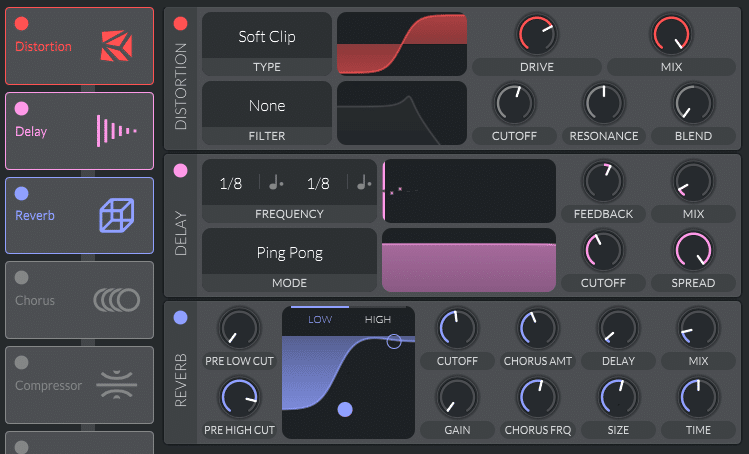
Last outcome:
Inside kinds akin to progressive home and techno, attempt to automate settings over time. This may help you preserve your observe attention-grabbing despite the fact that the melody doesn’t change a lot.
For instance, you may improve:
- the cutoff of your filter
- the quantity of reverb.
- the drive of your distortion
- the resonance of your filter
7. The Bounce Up Bass
Bounce Up has exploded in recognition within the 2010s by means of artists like Macky Gee. The fashion is immediately recognizable by means of one among its trademark sounds:
Unimaginable to not bounce when the drop is available in proper?! Let’s re-create that sound.
The number of the wavetable is essential right here. If in case you have the free model of Very important, the variety of wavetables out there is sort of restricted. So it’s value spending a while on-line downloading some free ones.
For OSC 1, I’ve chosen “Unhealthy Second” from the Tam LeTeet pack (available here). For OSC 2, I’ve gone with “Additive Squish 2” from the Glorkglunk pack (additionally available here).
The important thing right here lies within the fifth. Principally, our synth might be taking part in 2 completely different notes at an interval of an ideal fifth (7 semitones). First set OSC 2 up by two octaves:
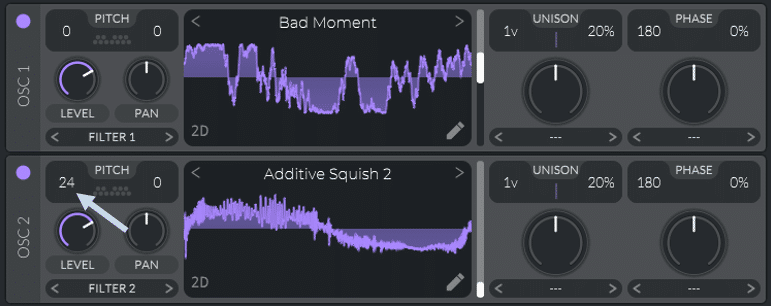
Subsequent, pitch it up one other 7 semitones. OSC 2 ought to now be 31 semitones above OSC 1.
Subsequent, let’s go to LFO 1, set it to Envelope mode, 1/4 notice, and draw the next form:

Drag LFO 1 to the cutoff of filter 1 in low-pass mode. Be sure that your filter opens up over a wide variety of frequencies:
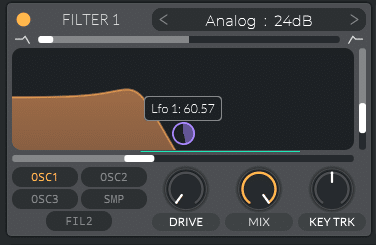
Be sure that solely OSC 1 is being despatched to Filter 1.
You can too apply LFO 1 to the wavetable place of OSC 1. This may give some further motion in your bass.
Up to now that is what you need to have:
Subsequent, let’s transfer to the FX part.
Apply some beneficiant distortion. I’ve gone with the Laborious Clip kind set at 9dB. Then, drag LFO 1 to the drive of your distortion. This may make your bass distort much more on every notice:
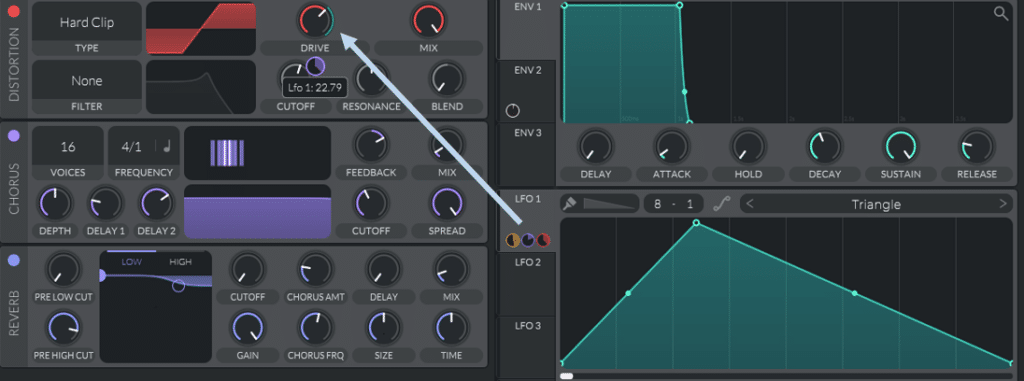
You can too add some gentle Refrain and Reverb so as to add some width and depth. Simply don’t overdo them or your bass will sound muddy.
At this stage we’re getting fairly near the ultimate outcome:
I wish to additionally add some Voice Transpose to provide the sound a bit extra assault.
To do that, go into Matrix, and choose Env 2 underneath Supply and International > Voice Transpose underneath Vacation spot.
Then attract a brief envelope in ENV 2:
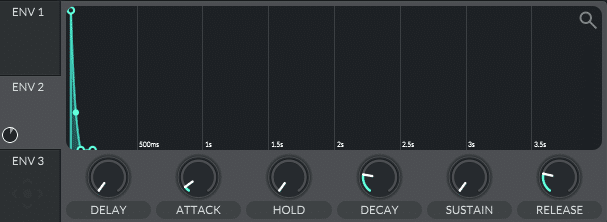
Now modify the quantity to style. For this sound I discover that being between 5% and 10% is sufficient:

And also you’ve bought your self a Bounce Up bass sound!
If you’d like much more grit, add some noise to the sampler. For the perfect outcome, be certain to route the sampler to Filter 1. Drag additionally LFO 1 to the extent:
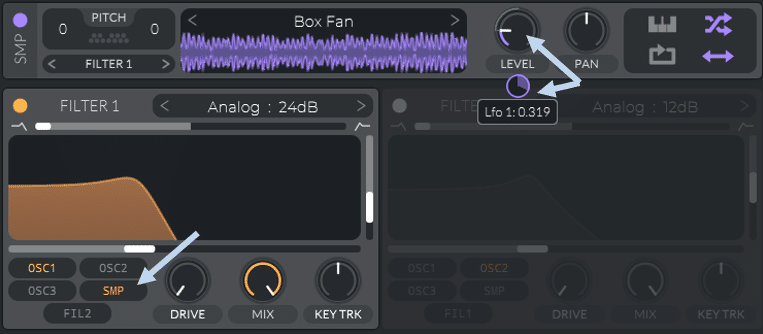
Right here’s my last outcome:
Good!
8. The Large Neuro Bass
Neurofunk has among the darkest bass sounds you’ll discover in digital music. Neuro basses are particularly darkish and gritty – let’s see how one can make one!
First load up a sine wave in OSC 1 and a sawtooth in OSC 2. Nonetheless, we’re merely going to make use of OSC 2 to modulate OSC 1. So flip the extent to zero, and choose FM OSC 2 underneath OSC 1’s Distortion kind:
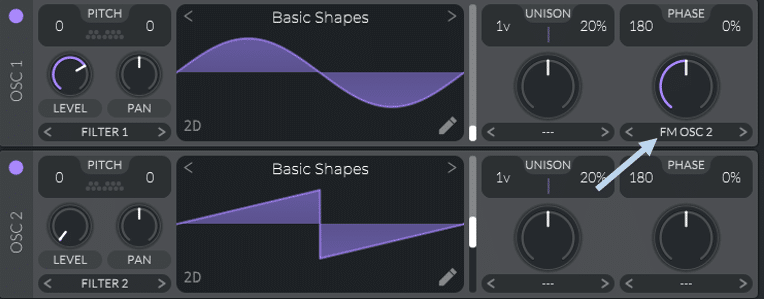
For OSC 3, choose a sine wave. This might be our sub frequency. Lastly, allow the sampler, however flip the extent all the best way down. We’re going to automate it later.
Now for some filtering!
Below Filter 1, choose Soiled 24dB. Then, draw the next form in LFO 1, with the next tempo settings:
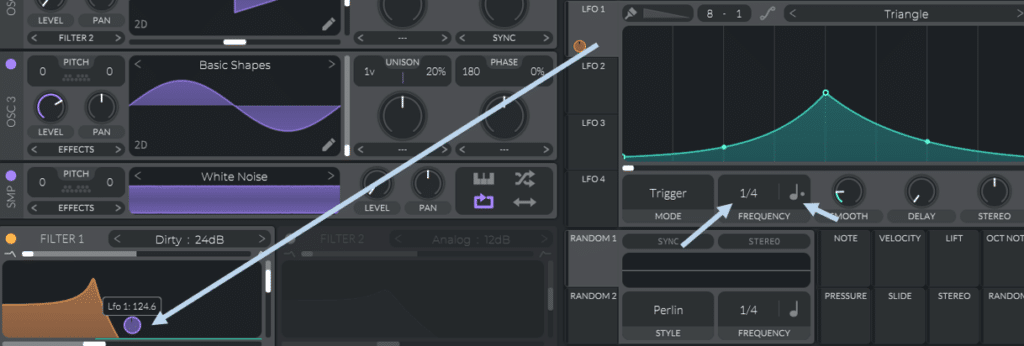
Up to now that is what you need to have:
Not there but, so let’s add some results. First up, some distortion. I’ve set mine to Mushy Clip with 15dB of drive.
The sound may get a bit muddy, so flip down the extent of OSC 1 and assign LFO 1 to it. Subsequent, do the identical with the extent of the white noise. That is what you need to have now:
We’re getting there! You possibly can modify the quantity of LFO and the filter cutoff level for various outcomes.
Subsequent, add some Refrain with the next settings:

Experiment with the depth and cutoff factors to seek out one thing you want.
Lastly, add some Compression and EQ:
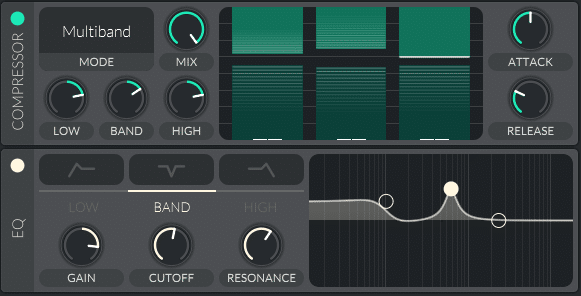
And that is what we’ve got:
And to prime it off, add some OTT and a little bit of reverb. Now you’ll be able to automate the Sync of OSC 2 in step sequence to create some cool variations:
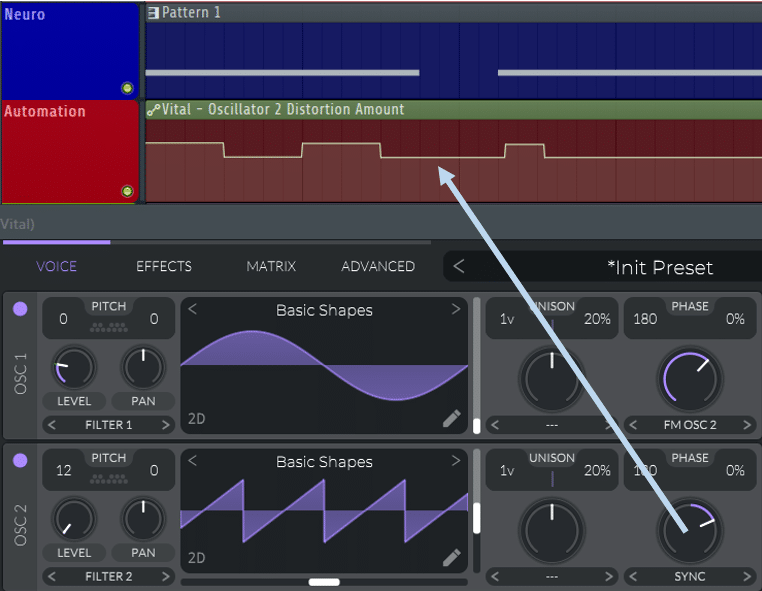
With this straightforward automation and simply taking part in one notice, that is the outcome:
Fairly nasty!
9. The Stabby Synthwave Bass
Lastly, for our final bass sound let’s discover the world of synth-wave.
For those who’re new to the world of synth-wave, you’re in for a deal with:
First, load up Very important and depart OSC 1 to its default wavetable. Drop it down 3 octaves and set the section to 0:

Subsequent, draw a “plucky” form for ENV 2 and assign it to the cutoff of filter 1:

That is what you need to have:
Subsequent, set LFO 1 to a sine wave. Set the frequency to “Keytrack” and drop it 2 octaves. Flip down “Easy” to zero, then drag LFO 1 to the section place of OSC 1. This may give our bass sound a metallic feeling:
For some further width, let’s add one voice to OSC 1 and detune it ever so barely:

Lastly, for the complete synth-wave expertise, let’s add some sidechaining.
We will really additionally do that is Very important. In LFO 2, set Mode to Sync and Tempo to 1/4 Observe. Then attract a form akin to this one:
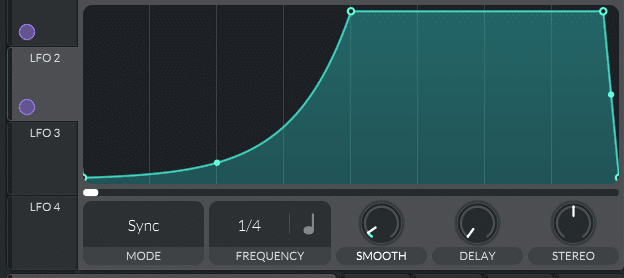
Then set the Stage of OSC 1 to zero, then assign LFO 2 to it and switch it to 100%. This ought to be the outcome:
Regulate the curve primarily based on the size of your kick and snare. And that’s it!
Final Phrases
I hope you discovered this information helpful! Keep in mind to all the time experiment with completely different settings to get attention-grabbing outcomes. And don’t be scared to use ideas from different genres to your individual!
Obtained any questions? Be happy to succeed in out to me at [email protected].
